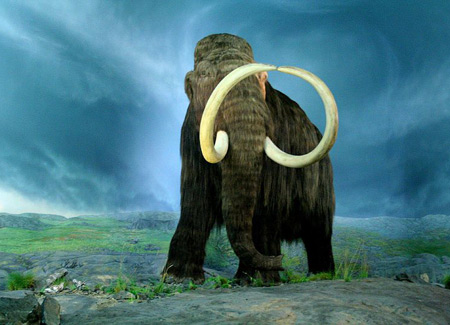
Last night at Southern Illinois University in Carbondale, a dozen faculty members and students gathered for a "mammoth barbecue" before the U.S. Public Broadcasting System's NOVA program laid out the story of the provocative--and highly controversial--proposal that a huge impact drove the mammoths and dozens of other large North American animals to extinction 12,900 years ago. The verdict?
"It was NOVA theater," says geologist and host Nicholas Pinter. "It was enjoyable, there were nice animals, but there was skepticism [expressed at the gathering] about the impact story." That, despite the first revelation of evidence from Greenland, added further support to an extraterrestrial killer.
A loosely-knit confederation of two dozen researchers had proposed the impact hypothesis in an October 2007 Proceedings of the National Academy of Sciences paper. They had found a half-dozen putative markers of high-velocity impact by comet or asteroid deposited in a thin sedimentary layer formed 12,900 years ago, at about the time of the extinction (Science, 7 March 2008, p. 1331). Those lines of evidence haven't held up, and the story now hinges on nanodiamonds. The nanometer-size bits of diamond had turned up in the same 12,900-year-old sediment layer across North America and in Europe, as the researchers reported last January in Science (2 January, p. 26). The nanodiamonds could only have come from an impact, they concluded.
On NOVA, viewers saw glaciologist Paul Mayewski of the University of Maine, Orono, and colleagues digging out Greenland ice of the same age as the nanodiamond-yielding sediment. And the ice too yielded nanodiamonds. "They're absolutely key to demonstrating a rain of comets at this time," Mayewski said on the show. Critics had complained that nanodiamonds continually drifting down in micrometeorites might have been somehow concentrated in the sediment layer, perhaps by being washed into a lake. But finding nanodiamonds in ice--where such processes wouldn't operate--counters that criticism, Mayewski and his colleagues said.
Impact scientists who caught the show enjoyed it but remain skeptical. "I still don't think nanodiamonds by themselves are a signature for extraterrestrial material," says mineralogist Bevan French of the Smithsonian National Museum of Natural History in Washington, D.C. Mineralogists still need to confirm that the nanograins are indeed diamonds, he says. And if they are, someone needs to figure out if they can come from somewhere besides meteorites. "I'm not convinced yet," he says, "but I'm willing to continue listening."



Reader Comments
to our Newsletter